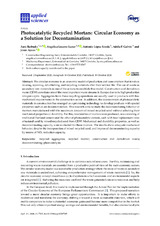Photocatalytic Recycled Mortars: Circular Economy as a Solution for Decontamination
Autor
Barbudo Muñoz, M. Auxiliadora
Lozano Lunar, Angélica
López Uceda, Antonio
Pérez Galvín, Adela
Ayuso Muñoz, Jesús
Editor
MDPIFecha
2020Materia
Recycled aggregatesRecycled mortar
Construction and demolition waste
Decontaminating
Photocatalysis
METS:
Mostrar el registro METSPREMIS:
Mostrar el registro PREMISMetadatos
Mostrar el registro completo del ítemResumen
The circular economy is an economic model of production and consumption that involves reusing, repairing, refurbishing, and recycling materials after their service life. The use of waste as secondary raw materials is one of the actions to establish this model. Construction and demolition waste (CDW) constitute one of the most important waste streams in Europe due to its high production rate per capita. Aggregates from these recycling operations are usually used in products with low mechanical requirements in the construction sector. In addition, the incorporation of photocatalytic materials in construction has emerged as a promising technology to develop products with special properties such as air decontamination. This research aims to study the decontaminating behavior of mortars manufactured with the maximum amount of mixed recycled sand without affecting their mechanical properties or durability. For this, two families of mortars were produced, one consisting of traditional Portland cement and the other of photocatalytic cement, each with four replacement rates of natural sand by mixed recycled sand from CDW. Mechanical and durability properties, as well as decontaminating capacity, were evaluated for these mortars. The results show adequate mechanical behavior, despite the incorporation of mixed recycled sand, and improved decontaminating capacity by means of NOx reduction capacity.

